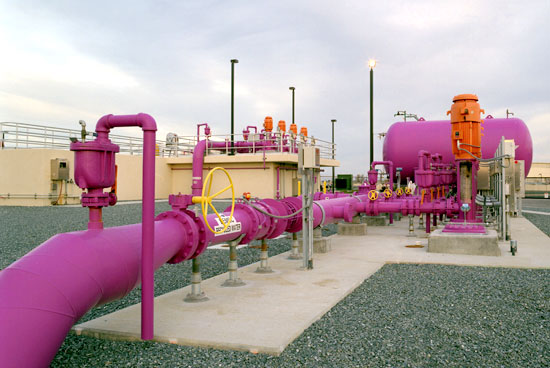Toilet to Tap or Great Idea! by Cody Black
A Popular Solution to a Growing Problem?
 As the drought continues, all of us are having to look at planning for a future with less water resources. For decades, we have been using recycled or reclaimed wastewater to irrigate our golf courses and large fields. These projects have been limited to certain high demand irrigation areas and have benefitted us in more ways than one. This includes providing a disposal location for wastewater treatment plant effluent while providing green open space in our communities. It is no surprise that this has been a popular solution, but will it remain so when even more restrictions are being placed on our household uses of water?
As the drought continues, all of us are having to look at planning for a future with less water resources. For decades, we have been using recycled or reclaimed wastewater to irrigate our golf courses and large fields. These projects have been limited to certain high demand irrigation areas and have benefitted us in more ways than one. This includes providing a disposal location for wastewater treatment plant effluent while providing green open space in our communities. It is no surprise that this has been a popular solution, but will it remain so when even more restrictions are being placed on our household uses of water?
Wastewater and Direct Potable Reuse
 As we look forward to the need for more conservation and more efficient uses of our resources, are Nevadan’s ready to take the next step to Direct Potable Reuse (DPR)? An increasingly popular solution with the hurdle of overcoming the “toilet to tap” moniker. Even with press conferences showing City Mayors and celebrities like Bill Gates drinking shiny clear glasses of treated wastewater, will the public accept the idea?
As we look forward to the need for more conservation and more efficient uses of our resources, are Nevadan’s ready to take the next step to Direct Potable Reuse (DPR)? An increasingly popular solution with the hurdle of overcoming the “toilet to tap” moniker. Even with press conferences showing City Mayors and celebrities like Bill Gates drinking shiny clear glasses of treated wastewater, will the public accept the idea?
This solution goes beyond indirect potable reuse, where some wastewater is blended with fresh surface or ground water and allowed to be introduced to a water treatment plant after certain residence time. With DPR, that treated wastewater goes through similar extensive purification and is then piped directly to a water treatment plant. This is why some call this “pipe-to-pipe” or “toilet-to-tap”.
The Benefits of Direct Potable Reuse
 Changing the regulations is where we start to get to the best efficiency of our resources. This is the direction that California is already headed. Direct Potable Reuse. This term is going to be talked about more and more in the coming years. Direct potable reuse is going to be a major tool for making the best use of our limited water resources.
Changing the regulations is where we start to get to the best efficiency of our resources. This is the direction that California is already headed. Direct Potable Reuse. This term is going to be talked about more and more in the coming years. Direct potable reuse is going to be a major tool for making the best use of our limited water resources.
This cannot be implemented without changing some regulations. California is moving toward DPR with their final California Legislature report due by the end of 2016 and Texas currently has DPR in operation in some plants. The technology to accomplish this is readily available. The next step is regulations and education.
Let’s spread the word about the benefits of direct potable reuse and look to the future where we can expand our populations while limiting the use of our precious water resources.
For more info on reuse: WateReuse.org

